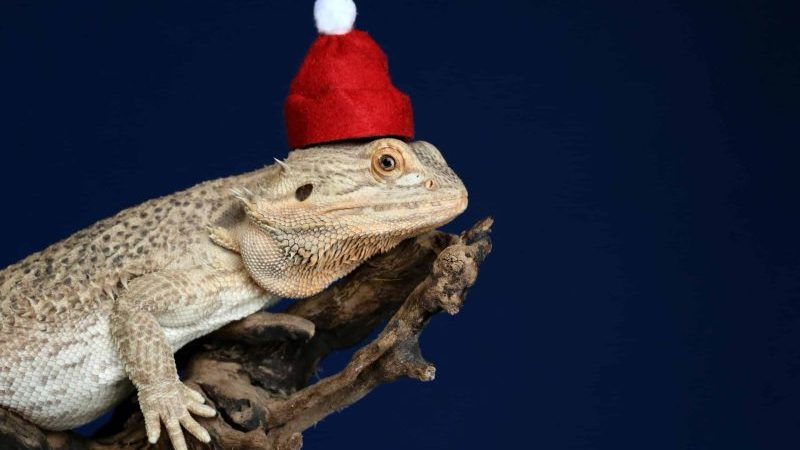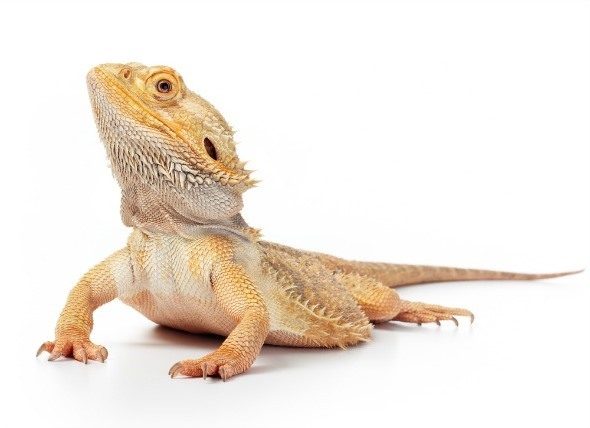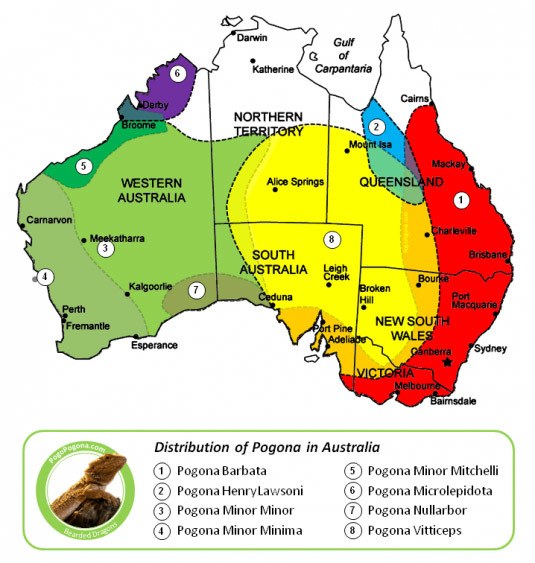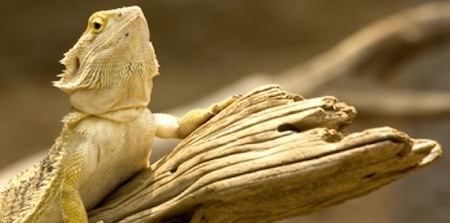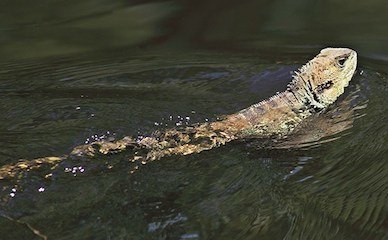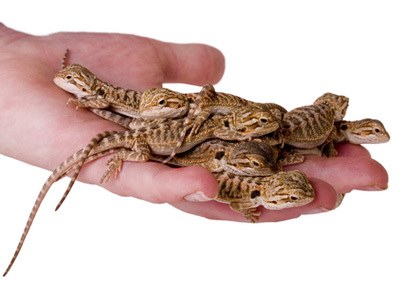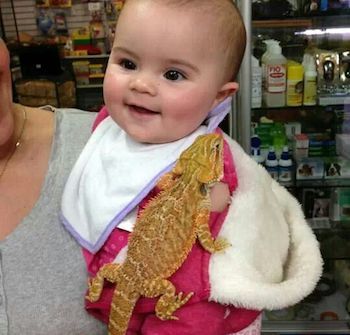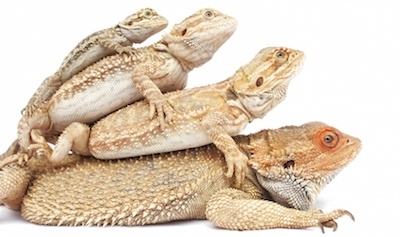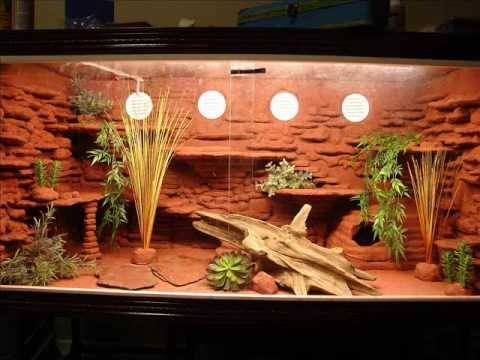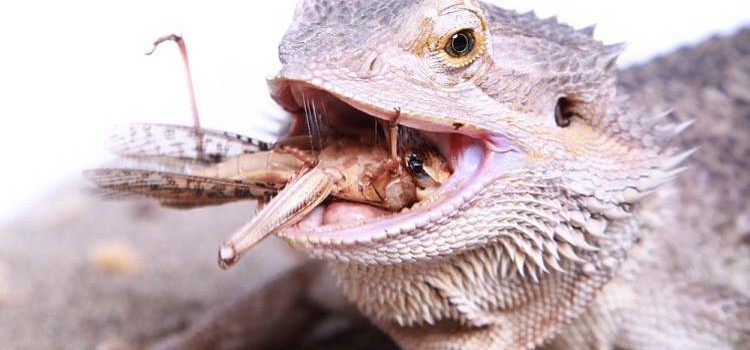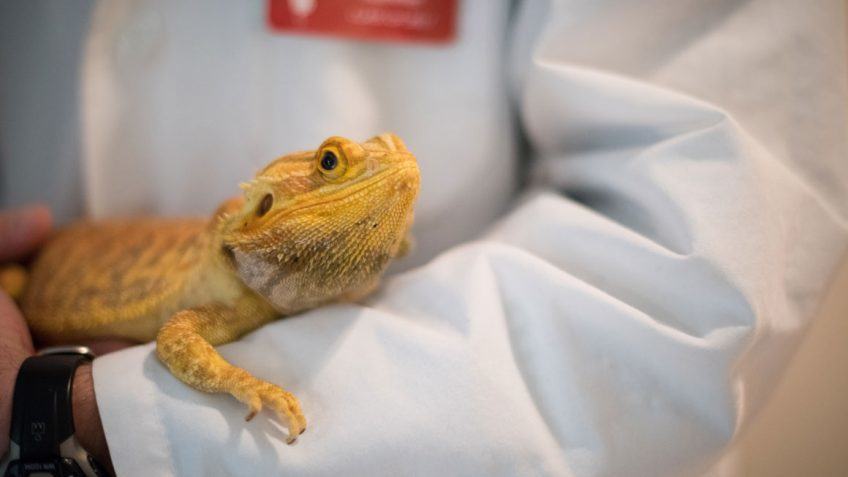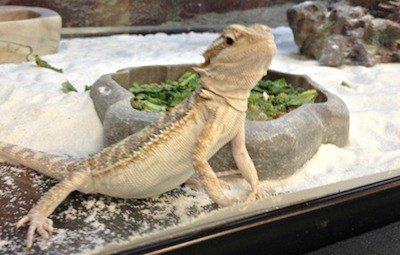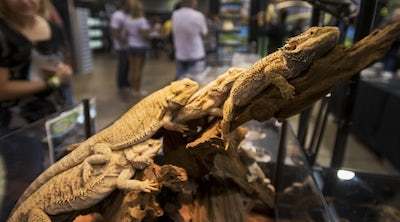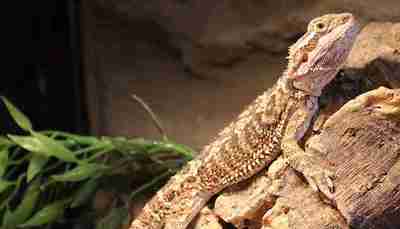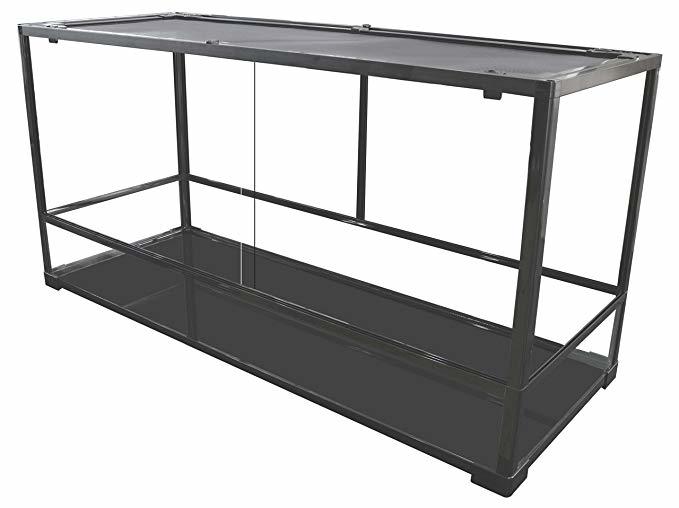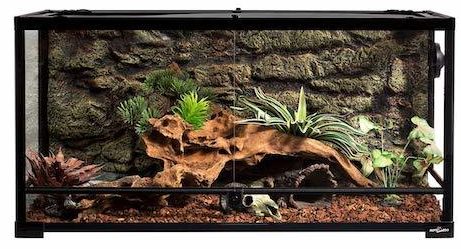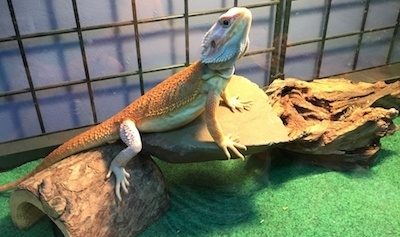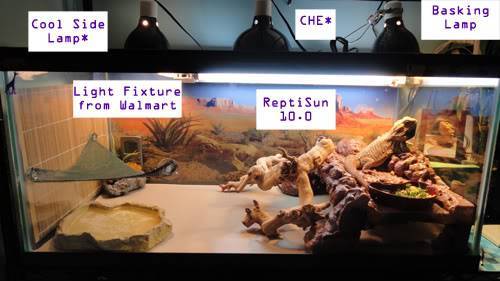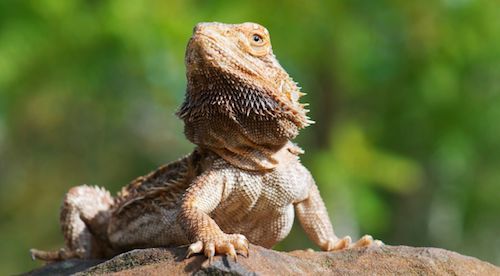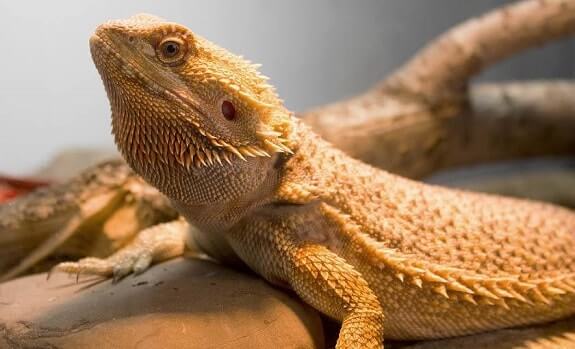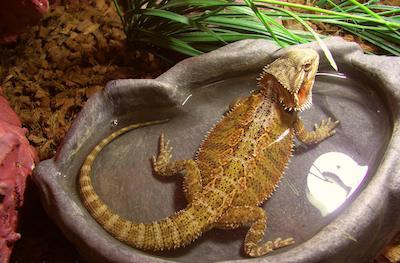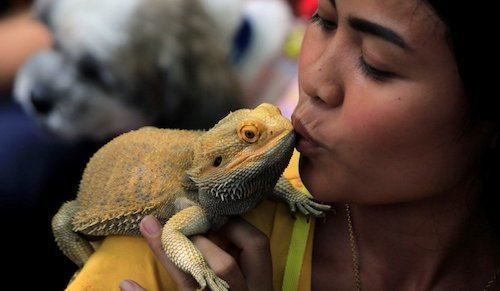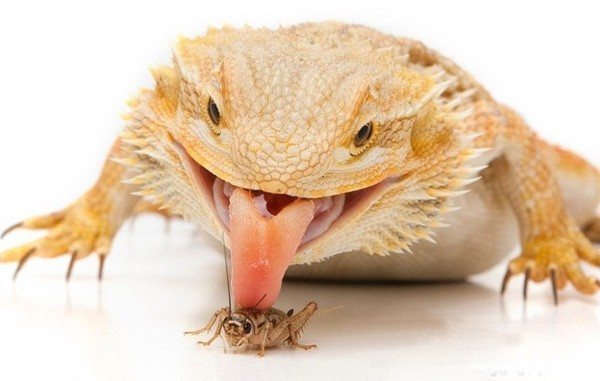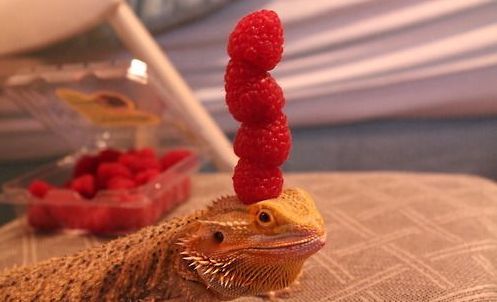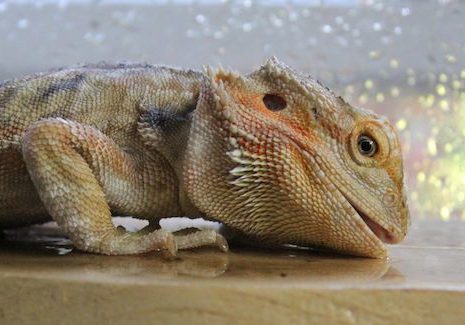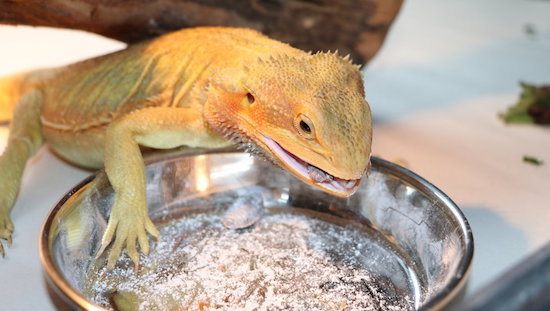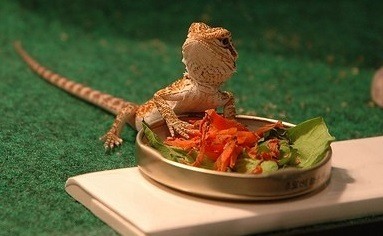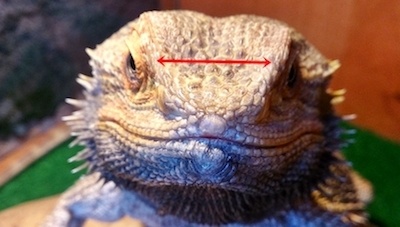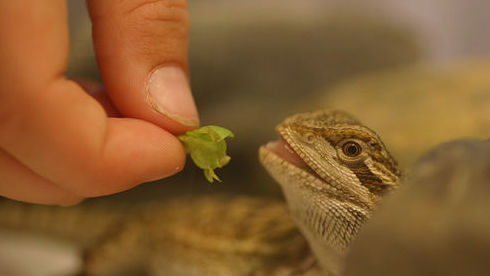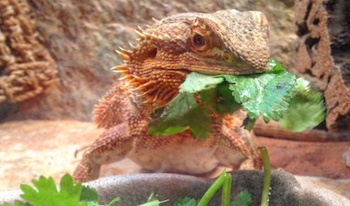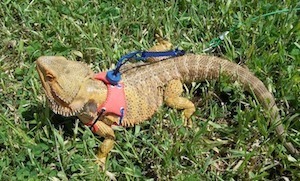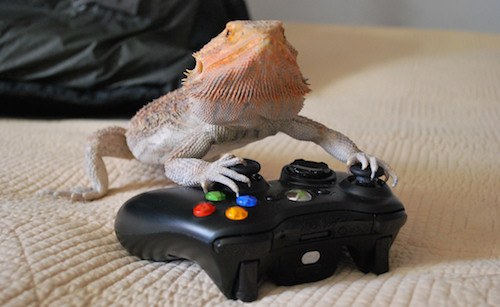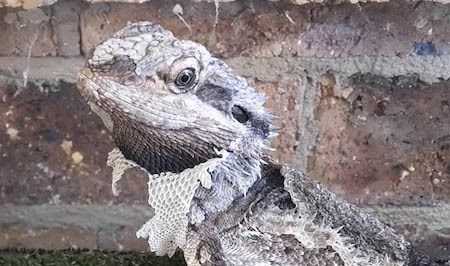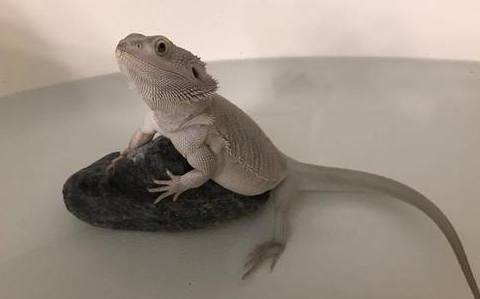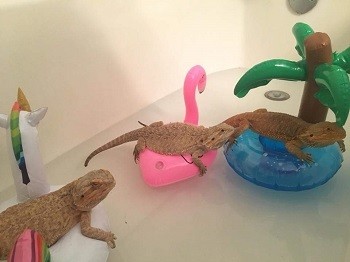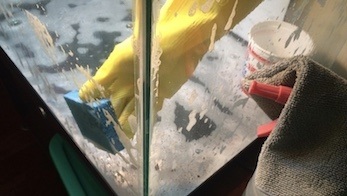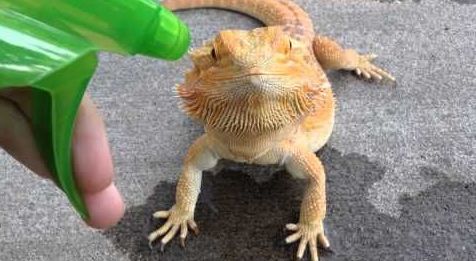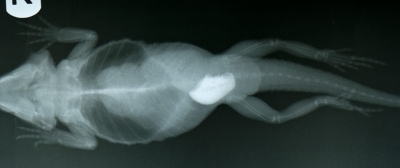Anyone with a bearded dragon will tell you… caring for them properly is hardly as common sense as it is with a dog or cat.
From very specific lighting and temperature requirements, to bizarre behavior (AKA glass surfing, head bobbing, and the famous arm wave), and strict dietary needs, it’s no wonder so many first-time owners find themselves stressed out with a sick or unhappy new pet!
Luckily, I’ve decided to put together a comprehensive Bearded Dragon Care Guide for Beginners that should take at least some of the stress out of caring for your new little guy or gal.
So, if you’d like to gain a better understanding of how to take care of a bearded dragon… simply keep reading! OR if you have a specific question/concern, simply use the Quick Navigation table below to be taken directly to that topic.
Disclaimer: You may want to pour a glass of wine and grab a snack because this is definitely a longer read. But trust me, you’re going to come out a expert! It’s fine, thank me later 😉
In This Article
What Are Bearded Dragons?
Appearance and Origin
Bearded Dragons (Pogona vitticeps) are dinosaur-looking reptiles with spiny scales and fascinating skin colors and patterns.
They’re named after the beard-like, spiky collars around their throats, which they inflate to intimidate other Dragons, or when they’re stressed out or in love (cute, right?).
Bearded Dragons, often called ‘Beardies’, come from Australia originally. They were introduced to the world in the 1990’s, and rapidly dominated the reptile pet market.
Interestingly enough, beardies have become so popular that in 2008, they helped reptiles surpass dogs and cats as the most popular pets in the UK!
There are eight different species of Dragon, all of them native to Australia, but the one most of us recognize is the Central or Inland Bearded Dragon.
Its scientific name is Pogona Vitticeps. It belongs to the Reptilia class and the Pogona genus (common group). Vitticeps refers to its specific species.
By 2017, there were 9.5 million reptile pets in nearly 5 million American households, and Bearded Dragons had become the fourth most sought-after reptile pet in the world!
Different types of Bearded Dragons live in various climates, including sub-tropical, ocean shore, woodlands and shrublands.
Our Pogona Vitticeps hails from the arid desert center of the Australian continent, so it thrives in extreme heat and light.
Like all reptiles, beardies are cold-blooded or ectothermic, meaning their body temperature is regulated by environmental heat and cold.
For this reason, they’re diurnal, meaning they’re mostly awake during the warmth of the day and asleep in the cooler night–just like their human caretakers.
In the wild, you’ll see them basking in the sun on rocks or trunks and branches.
Near cities, they seek out telephone poles or other human-made wooden structures. Dragons are good climbers, and like to climb to favored sunning spots.
During the hottest part of the day, though, Bearded Dragons head for underground burrows to avoid overheating.
They stay underground at night, too, to sleep in the warm earth and avoid nocturnal predators.
Bearded Dragons are omnivorous. They eat almost anything–insects, snails and slugs, even other lizards and dead animals, and also fruit, greens, vegetables, and flowers.
They get water from their food, and from dew, mist, and rain.
Dragons are also good swimmers, with some coastal species more accustomed to swimming than others.
Gender Differences and Mating
Male Bearded Dragons are aggressively territorial, and very protective of their immediate living space.
They’re fast runners, which helps them dominate their territories, catch food, and escape predators.
They don’t congregate much except to fight, and don’t usually do very well sharing home-raising environments with other Beardies.
Bearded Dragon males become sexually mature within their first year and a half. They fight off all other suitors in their territory and mate with multiple females.
A month or so after mating, females bury up to two-dozen eggs in warm soil. The eggs incubate for about two months.
When a Bearded Dragon baby (called a hatchling) is born, it weighs about 2 grams, and measures just a few inches in length.
Fully-grown, an Inland Dragon male measures 20-24 inches in length, nose to tail, and weighs a pound or more. Females are a little smaller. Overall you need to know what you’re looking for to sex a bearded dragon. Or have you heard of a hemipenis before?
It’s been illegal to export Bearded Dragons from Australia since the 1960’s, so most of them in the Western world are bred in captivity.
Breeders have created many hybrids, or morphs, by selecting Dragons with specific gene traits and mating them.
You’ll find Dragons in different colors, patterns, skin transparencies, and sizes (even giants and dwarfs).
Why Do Bearded Dragons Make Good Pets?
Compared to other reptiles like snakes, chameleons, and turtles, Beard Dragons are remarkably easy to care for. This makes them great pets, especially for kids.
As long as they’re hot, clean, fed a couple of times a day, and have enough space to move around in, they last a long time and present few complications. Other reasons why Beardies are desirable:
- They’re cute.
- They’re awake when we’re awake, so it’s easier to interact with them.
- They’re generally docile and passive, which means handling them is safe and fun.
- They eat a lot of different things, and are generally not too picky about it.
- They’re small enough for most houses or apartments to accommodate their habitats, but large enough to survive being handled by smaller children.
- They live a long time, 4-12 years, so their caretakers have plenty of time to bond with them, and often grow up alongside them.
- They’re relatively inexpensive to set up and maintain, and if treated properly rarely need medical attention.
15 Fun Facts About Bearded Dragons
- Bearded Dragons are able to see in full color, just like humans!
- They have a third eye on their foreheads, called a parietal eye. This isn’t a fully-developed, image-processing eye, but a set of photo-electric cells that sense the difference between light and dark. This eye helps Dragons escape predators swooping down from above.
- Bearded Dragons can lock their knees and sleep standing up.
- Breeders have created all sorts of colored Bearded Dragons, but in the wild, their colors come from the soil of their native region.
- Wild Dragons can go weeks without eating.
- If they are stressed out or under attack, they harden and stiffen their normally-soft spiky scales to provide sharp armor protection.
- Smaller Dragons will ‘wave’ one hand in a circular motion to show submissive to a larger one.
- Dragons smell and taste with an organ on the roof of their inner mouth.
- When it mists or rains, the bumps and spines on Bearded Dragons’ skin help them collect water. To drink, a Dragon bows its head to allow water to flow down its back and onto its tongue.
- Beardie’s side teeth are permanent, but their front ones will fall out and regrow.
- Unlike other lizards, Bearded Dragon tails and limbs won’t regenerate if they’re pulled off by predators.
- Bearded Dragon colors and patterns can change, sometimes dramatically, after every shed, and Dragons often eat their skin after shedding.
- They can sprint 9 miles an hour, and fast-moving beardies automatically rise up and run like bipeds. An evolutionary ‘flaw’ causes their center of gravity to shift to the rear (like a jet fighter’s) when running quickly. It’s actually impossible for the Dragon to remain on all fours at this speed.
- In extremely dry conditions in the wild, Bearded Dragons excrete dry urine to conserve water.
- In captivity, Bearded Dragon males will establish dominance over others by lying on top of them, depriving them of critical UV light.
Discover more fun facts about bearded dragons here!
Bearded Dragon care costs
Bearded dragons can vary dramatically in cost, especially in the beginning when you decided how much to spend on their enclosure.
Over the course of their life, however, if kept healthy you can expect costs to be pretty fixed and low.
However, this will naturally depend on the diet you feed them as well. Read on to get a better idea of costs associated with raising a beardie.
Cage Setup
Depending on how simple or sophisticated you want or can afford to be, and whether you find an amazing deal from a previous owner, an all-new Bearded Dragon setup will cost as little as $150, or more than $500.
Here’s how the basic necessities break down, price-wise.
A glass or plexiglass aquarium or terrarium makes a good first/permanent habitat for a Beardie. It’s easy to find good deals on new and used aquariums and terrariums.
Start with a 25 or 30-gallon tank for a baby Beardie under 6 months and be prepared to pay around $25-$50 for one that’s brand new.
However, if you want to save yourself some time, money, and energy… start your baby off in a 40 gallon or so as this will be suitable until they’re around 10-15 months old.
If you’re considering an adult, you’ll have to go with at least a 40 gallon tank (although I recommend at least 75 gallons for a truly enjoyable space…) and should expect to pay anywhere from $100 all the way up to $500 if it’s custom made.
Additional accessories for the habitat may run you another $100. These include a suitable substrate (flooring); thermometers/hygrometers for measuring heat and humidity; basking branches and rocks; heating pads for nighttime temperature control; food and water dishes, and dietary supplements.
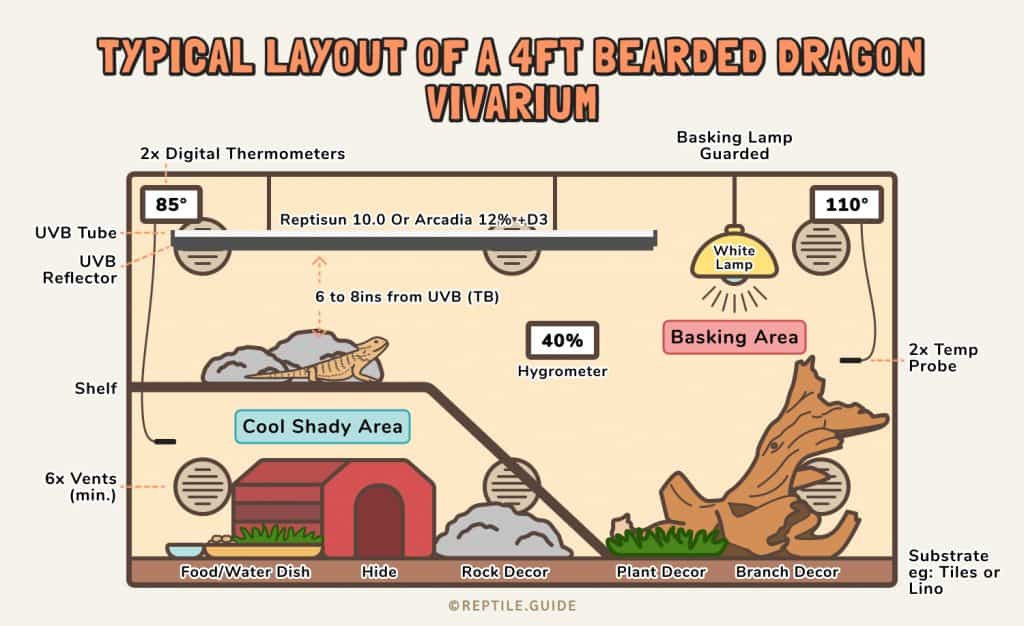
The costliest (but most important) initial outlay is for the basking light and UVB bulb. A lizard needs both physical light (UVA) and heat (UVB) to survive.
There are numerous retail variations you can choose from, but for beginners, I highly recommend opting for the Repti-Sun 10.0 UVB bulb and any household bulb for your physical light source AKA the basking light.
Interested in learning more about UVA/UVB? Check out my Bearded Dragon Lighting Guide by Clicking HERE!
Diet
If you feed your Bearded Dragon “feeders” AKA live food, which I recommend, you’ll need a least one ‘critter keeper’ to manage your live food and make feeding a breeze.
The large, feeder-tube version of the All Living Things Kricket Keeper is relatively inexpensive and will keep your crickets and other Bearded dragon food alive and kicking.
Insects like crickets, Dubia roaches, and mealworms cost anywhere online from 5 – 20 cents apiece, or $5 – $15 per week.
Dragons eat vegetables that are probably in your house already, so you won’t incur much additional expense there.
Additionally, calcium supplements and vitamins shouldn’t cost more than a few dollars a month.
Food costs overall will diminish as your Bearded Dragon gets older, because its diet switches from mostly bugs to mostly greens.
Click HERE to Discover the 3 BEST Places to Buy Crickets Online
Cohabitation
Beardies are solitary creatures, so it’s not recommended that you keep two Bearded Dragons in the same environment.
The rule is: One habitat, one Dragon.
A young Dragon can sell for as little as $15 – $20 at reptile fairs, and will run you about $40-$70 at national chain pet stores.
If you want a rare or exotic color or morph of a Dragon, a breeder could charge you $250 or more.
Such an investment for a first-time owner is probably unwise. Learn and practice proper Beardie care first.
Medical Costs
Vet checkups and medical bills range anywhere from $20 to a few hundred dollars, depending on the needed care.
You could purchase health insurance for your Bearded Dragon for as low as $9 a month.
The good news is that if you care for your Bearded Dragon properly, it’s unlikely you’ll have to spend much on Dragon healthcare. Their hardiness is one of their primary assets as pets.
Finally, remember that a Bearded Dragon costs you time. Your reptile is not a toy. You can’t just keep it in a box and feed it twice a day.
It’s a living creature with needs, and you have to provide the animal interaction it’s not going to get anywhere else.
So make sure you have the time to spend a little time with your pet. Feel a sense of responsibility for the welfare of your Dragon.
Where Can I Buy a Bearded Dragon?
The #1 rule in shopping for a Beardie from any source: Do your homework!
Does the store or breeder have a good reputation? What do customer reviews say about them? Are they doing a lot of reptile business? Do they know about Bearded Dragons, or do they raise Beardies themselves?
Pet Stores
Most first-time Bearded Dragon owners in the United States get their Dragon from a local chain pet store. A big benefit of dealing with these retailers is that they can usually set you up with everything you need to get started.
Pet store Dragon prices trend lower for Dragons, too, because they generally trade in generic Vitticeps, not the exotic color hybrids that private breeders offer. And they’ll probably have a wider number of baby Beardies to choose from, which helps you find the right one for you.
However, pet stores are infamous for providing inadequate or misleading information about the care of Bearded Dragons. Their staff often doesn’t have direct reptile experience, so don’t rely on them for that. Do your own research.
Also, retail Beardies are known for not being as healthy as those from breeders, because they’re shipped and displayed with lots of others. Stores usually don’t test their dragons for common viruses that spread among groups (one of the most dangerous being the adenovirus or atadenovirus).
In general, I do not recommend buying from a pet store. You’re just taking far too great a risk when it comes to ensuring your new pet is healthy in my opinion.
Breeders
Check the Internet for a reptile or Bearded Dragon breeders in your state or local area. You can find breeders in Bearded Dragon groups on Facebook too.
Many professionals breed specifically for certain patterns and colors.
If you’re looking for a particular morph you’ve seen, or want exotic colors and physical features, a breeder is the way to go.
Some specialize in high-end Dragons, but you can find smaller breeders who offer dragons in the pet store price range.
As a first-timer, you really just need a breeder who’s a true reptile or Bearded Dragon enthusiast, and knows a lot about their care.
If there happens to be a reptile show near you, check it out. You’ll meet breeders personally that way, and often find quality animals for less than you’d pay elsewhere.
In general, breeders tend to sell healthier animals and know more about Beardies. But as in the case of pet stores, not all breeders are created equal.
Remember the rule: Do your homework! Check reputations and read reviews. Look for recommendations. Ask questions. Trust your instincts.
Classified Ads/Facebook Groups
It’s not unusual to find amazing deals on complete Bearded Dragon and habitat packages through Craigslist or other online ads.
Many new owners didn’t thoroughly research their Dragons up front, and now find they can’t care for them properly.
However, perhaps it goes without saying that you’ll want to be careful, of course.
You have only the word of the seller about how their Beardie has been treated; you might be purchasing someone else’s problem.
Also, you should expect to have to replace lights, thermometers, and so on, after you take ownership of the Beardie.
Reptile Rescues
Though many Bearded Dragons come to reptile rescues from abusive or neglectful situations, you could still consider a rescue Beardie.
Most reptile rescues perform thorough health and temperament checks before offering animals to the public. Some even have skilled exotics veterinarians on staff, and require all their reptiles to exhibit normal behavior before they’re eligible for adoption.
You’ll probably pay a small fee or donation for a rescue Dragon. You may need to prove you have an adequate environment for your rescue Dragon, and to sign a ‘no flipping’ agreement (to prevent you from buying rescues cheap and reselling them for a profit).
Rescuers work to place their rescues in loving, qualified, permanent homes, and will offer to take them back from you if things don’t work out.
What Kind of Home Does My Bearded Dragon Need?
Tank/Vivarium
Set up your Bearded Dragon habitat before you bring your pet home; its environment should be warm and ready as soon as your Beardie comes through the door.
There are many kinds of reptile habitats, but a glass/plexiglass aquarium or terrarium with a mesh lid is the simplest and least expensive to set up, and allows for the best viewing of your new pet.
Such a tank is heavier than other habitats, but its transparency offers the Bearded Dragon a sense of space.
There aren’t a lot of opaque walls in the wild, and there shouldn’t be in its home-raising environment!
When choosing a vivarium, which is what the habitat is technically called once your reptile’s in it, remember that no tank is too big for a Bearded Dragon.
Some are too small, however. You don’t want to skimp on space, because not enough living room will stress out your Dragon, increase the risk of health problems, and literally stunt its growth.
For a 4″ – 6″ baby Beardie, a 25 gallon tank offers enough room and is easy to heat and light properly.
By the time your bearded dragon reaches 6 inches and certainly no later than once they reach 10 inches (usually by the time they’re around 4 months old)… you’ll need to upgrade them to a tank that’s at least 40 gallons.
Because this upgrade happens so early on in life, I honestly recommend just starting with a 40-gallon tank and saving some money by eliminating one tank upgrade.
Plus, it’ll just save you more time, energy, and stress having to move your bearded dragon one less time.
From here, you won’t need to upgrade to a larger tank until you’re dragon is around 10-16 inches long or between 10-15 months old. As such, I recommend checking out this 40 gallon tank OR this nicer 50-gallon tank to get started.
Once your Bearded Dragon reaches the 15-month mark, I recommend transitioning them from the 40-50 gallon tank into at least a 75 gallon tank.
Please note that while you can keep an adult beardie in a 40 gallon tank, it really is a tight squeeze and you’d be hard pressed to find a breeder or loving owner who supports this. Don’t be a jerk, give your pet a more comfortable space.
When it comes to the lid of the vivarium, it should be sturdy enough to support a light dome, but also meshed or screened to prevent moisture from building up in the tank.
Click HERE for My Top 3 Bearded Dragon Cage Recommendations!
Substrate
The substrate is the floor or ‘soil’ of your Bearded Dragon environment.
Pet retailers often sell sand, pebbles, or wood chips as natural environment elements, but these materials can be dangerous for home-raised Bearded Dragons, especially young ones.
Grains of sand or splinters can get into the digestive tracts of Bearded Dragons and cause impaction, a potentially fatal form of constipation.
Pressed felt and other fibrous cloth substrates present a similar problem, as Beardies can bite the cloth and swallow small threads.
Click HERE to Read More About Substrates (Which Ones to Use, Which to Avoid…)
Reptile carpet is probably the best substrate choice for a new Dragon owner, and provides good footing for your pet.
Get two of these, cut to fit your habitat, so that you can lay a new one down while cleaning the other. You can also use paper towel or newspaper, too.
Just remember, with any kind of substrate, it’s important to watch for bulges and other irregularities that allow crickets or other insects to hide from your pet.
Light and Heat
To be healthy and happy, Bearded Dragons need a lot of heat and full-spectrum light –just as they’d get in their native Australia.
UVA (long wave ultraviolet A), or visible light, generates heat and sets the day/night cycle. It also stimulates Beardie’s appetite, helps them digest food, and levels their mood.
UVB (short wave ultraviolet B) is an invisible form of radiated energy that provides Dragons with vital vitamin D3, which triggers the absorption of calcium from their diet.
Without adequate UVB, Dragons suffer from metabolic bone disease (weak and brittle bones), as well as lethargy and growth problems.
Dragons need 12-14 hours of UVA/UVB light every day. Even if your vivarium gets natural sunlight, most of the UV in that light will be filtered by window or tank glass, so lamps are always necessary.
All-in-one, full-spectrum lamps like the MyComfyPets UVB and UVA 2-in-1 Reptile Bulb can get you started with a baby Beardie.
However, for a larger Dragon I recommend you do things the old fashion way and get a separate heat/basking and UV lamps.
These can be dually or individually mounted above the tank (if they’re in ceramic-fixture domes, you can even place them directly on the mesh lid).
Retailers offer several types of UVB lights. The most powerful are Mercury Vapor Bulbs (MVBs), suitable only for large tanks because of their high ultraviolet output.
I recommend only going with an MVB bulb if you are an experienced owner OR prepared to do your homework. These bulbs are extremely strong and can burn beardies. I recommend the Evergreen UVB bulb.
Perhaps a more beginner friendly choice is fluorescent or Linear Tube lights, which produce less UVB than mercury vapor lamps, but more evenly distribute ultraviolet light across the habitat.
Look for the Reptisun 10.0, it’s an absolute favorite amongst even the most picky owners.
Compacts/Coil lights are often sold as environmentally sound alternatives to UV lights, but they just don’t provide consistent UV, or enough of it. Avoid them.
All UVB lights should be on in conjunction with basking lights, and for the same duration.
Pet stores sell basking lamps, but unfrosted, large-wattage household bulbs or Halogen floodlights can provide just as much white light and heat.
Bearded Dragons like things hot, but how hot is hot?
The best Bearded Dragon environments will have a hot side, closest to the basking lamp, of about 95-110F. The ‘cool’ side, furthest away from the heat source, should top out at 85F.
Nighttime temps can drop to the low 70’s, but if your house is cooler than 65 degrees Fahrenheit (or 18 degrees Celsius) at night, you’ll need a Ceramic Heat Emitter (CHE). I recommend this affordable 2 pack and this fixture.
Most retailers offer thermometers and hygrometers that monitor and/or schedule habitat temperature as well as humidity...both of which are critical to maintain.
The simple round stick-on thermometers are notoriously inaccurate, so get an inexpensive digital one.
Before bringing your Bearded Dragon home, be sure to have its environment already set up–and warm!
Basking Accessories Like Branches, Rocks, and Hidey-Holes
Bearded Dragons spend most of their daytime hours basking in heat and light, so provide yours with at least one big perch to do so. Clean, bark-free branches are ideal for this purpose.
Avoid outdoor branches, as they can contain insects, parasites, or chemicals you don’t want your lizard exposed to (especially if your yard is pest-controlled).
Artificial rocks make great basking platforms, too, though you should avoid electrically heated ones. Beardies don’t have a lot of pain nerves in their underbellies, and can burn themselves.
In their natural habitat, Bearded Dragons head underground during the highest temps, so give your Dragon a hidey-hole or hide box.
Basking rocks often double as hides; just make sure that the entrance is big enough for it to enter and the space large enough for it to freely move around in.
Click HERE to Check Out the Best and Safest Plants for Bearded Dragons
Dishes and Bowls
Bearded Dragons need a food dish for greens and fruit. The edge of the dish should be high enough to keep food from spilling onto the substrate, but low enough for a young Bearded Dragon to access it.
Many Bearded Dragon won’t drink water directly from a dish, but some do, and in this instance, you should keep a shallow water dish available. As with the food bowl, shallow and accessible is the key.
If your beardie doesn’t enjoy drinking water, you can gently mist them once a day with water or give them 2-3 weekly baths of no more than 15 minutes in shallow water that doesn’t surpass their vents. Just be sure to monitor them.
Either option works as beardies absorb moisture through the skin to stay hydrated.
Click HERE to Read About More Must Have Bearded Dragon Accessories!
How Do I Choose the Right Bearded Dragon for Me?
Unless you have your heart set on a particular exotic bearded dragon morph color, or have decided you want an adult, you’ll probably end up at the baby Dragon tank at your local pet store.
Did you know there are 8 species of bearded dragons recognized in the world?
Ideally, you want a Bearded Dragon that you bond with right away, so look over all the prospects.
Do any of them catch your eye? Does one appear cuter, uglier, prettier, more/less aggressive than the others? What are you thinking and feeling as you look at each one?
If you think you’ve found a Dragon match, ask staff to let you handle it.
If you’re lucky, you’ll be allowed to reach into the tank. Does your favorite baby Beardie approach you? Do any of the others?
Does the Beardie allow you to pick it up (gently, around the mid-section, with cupped fingers)? How does your Dragon respond to being held? Does it relax in your hand, or struggle to get away? Does it seem friendly or disinterested? Does it let you feed it?
Bearded Dragon Health Checklist
Examine your baby Dragon carefully for injuries or potential health problems:
- Is it at least four inches long (if not, it’s too young to take home)?
- Is it alert and responsive?
- Are there any scars, or missing limbs or toes?
- Are any parts of its body or appendages swollen?
- Is its belly full and round?
- Are its eyes sunken, cloudy?
- Do you see any discharges from the eyes, nose, or the other end?
- Does its skin look dull or loose?
- Does it move in a jerky, trembling manner?
- Does it appear mean or sullen, willing to snap?
Any one of these checklist items could indicate a bad choice for a pet, and more than one likely means a sick animal.
But assuming your Beardie appears healthy, are you ready to commit to this one? If not, try another.
If you don’t bond with any of them, you can take your chances with a random pick, wait for another day, or try a different Dragon provider.
Choosing carefully now will probably save you time later.
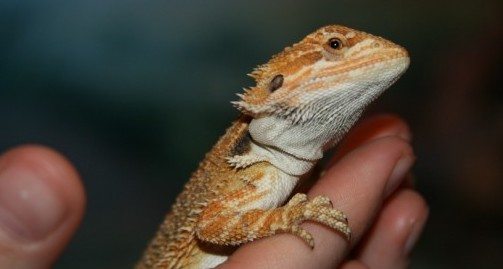
It’s difficult to determine the gender of a baby Bearded Dragon, and unless you plan to breed someday, gender really isn’t an issue in picking a reptile pet.
The point is to be as sure as you can that you’ve found a good fit before you hand over your hard-earned dollars for a beardie. This is a long-term investment, not to be entered into lightly.
If you think you’ve found your Beardie, it’s time to take your new pet to the home you’ve set up for it!
What Should I Feed My Bearded Dragon?
Protein
Food tends to be sparse in their natural habitat, so Beardies have adapted to eat both plants and animals.
Crickets are the most common protein food for home-raised Beardies, though fat-rich dubia roaches are often preferred by experienced Dragon owners.
Don’t gather or use insects from your garden or lawn, as they’re likely to be contaminated with pest-control chemicals.
Mealworms make good secondary sources of protein, but since they’re covered with relatively hard shells, these calcium and fat-rich worms should be offered only occasionally, as treats. Young Bearded Dragons sometimes have a hard time digesting them.
Veggies and Fruit
Bearded Dragons eat a wide variety of vegetables, fruits, and flowers.
Each Beardie develops its own preferences, so offer as many different types as you can.
Beardies eat most dark, leafy greens like kale, arugula, dandelion, mustard, collard and endive.
They like alfalfa sprouts or green beans, too, or watercress and bok choy. Include yellow, red and orange vegetables in their diet, like acorn, butternut, or yellow squash, bell peppers, and carrots.
Only occasionally feed them spinach, Swiss chard, peeled cucumbers, beet greens or zucchini.
Always avoid iceberg and other head lettuce and celery, as these are water and fiber-rich but largely devoid of nutrients, and can cause stool problems.
Fruits are low in minerals and other nutrients and high in sugar and water, but they can attract young beardies to greens (by mixing them in).
Options are strawberries and other berries, bananas, grapes, tomatoes, peaches, kiwis, and melons, as well as high-in-calcium figs and dates, and apricots.
Bearded Dragons eat flowers, too. Carnations, dandelions, geraniums, geraniums, hibiscus, and roses make nice treats–but don’t give them to your Beardie if you suspect they’ve been treated with pesticides.
NOTE: Do not feed avocados to Beardies, as they’re essentially poisonous. Same with most mushrooms. And citrus fruit is generally so acidic that it wreaks havoc with Bearded Dragon digestion.
Water
It’s commonly stated that Bearded Dragons get most of the water they need from the protein and greens they eat.
But dehydration is extremely common among home-raised Beardies, so the consensus among experts is that Dragons should have daily access to fresh water in a dish.
If your bearded dragon shows no interest in a water dish, mist your Dragon with a spray bottle once a day to hydrate it.
Dragons will drink water directly from their foreheads and noses, so don’t be afraid to spray its head. Weekly or monthly warm baths help keep Beardie skin properly hydrated, too.
If you live in a high humidity area, however, you’ll need to be careful about the humidity level in your Dragon’s habitat. This is where having a great hygrometer can come in handy.
Bearded Dragons can develop respiratory and other complications if there’s too much moisture in the air.
If you see any condensation whatsoever on the glass in your tank, back off on the water.
Related: Discover the Best Ways to Lower the Humidity in a Bearded Dragon Tank
Dietary Supplements
If you’re feeding your Bearded Dragon healthy crickets, along with safe fruits and vegetables, then your pet should be getting most of the nutrients it needs.
But every Dragon has foods it just won’t eat. Science still hasn’t determined precisely what Beardie nutritional requirements are, so you should err on the side of caution and assume you need to supplement its diet.
Tip: If your bearded dragon won’t eat veggies, try this miracle salad dressing, it works like a charm!
Since calcium deficiencies create a host of serious health issues, it’s considered a best practice to add calcium to your Dragon’s daily food plan. Vitamin D3 is considered critical for Beardie health, too.
As a general rule of thumb, I recommend opting for a calcium supplement WITH D3 if your beardie’s vivarium doesn’t use a Mercury Vapor Bulb.
Try this supplement if you need a calcium supplement WITHOUT D3.
NOTE: Some supplements contain Vitamin A, and Beardies are particularly sensitive to Vitamin A toxicity. Instead, opt for vitamins/supplements with beta carotene which only converts what the body needs in vitamin A. Never more.
Finally, Beta-Carotene deficiencies can cause the fading of your Bearded Dragon’s skin color. You can avoid this problem by including more carrots and yellow vegetables in your Beardie’s veggie dish.
How to Care for a Bearded Dragon?
Daily Feeding and Cleaning Routine
Because Bearded Dragons are cold-blooded, they can’t properly digest their food unless they’re warm enough inside (100F). So don’t feed your Dragon right after turning on the morning lights! Give your reptile a little time to heat up.
Conversely, don’t turn the lights off immediately after its second/final meal of the day; let it digest for an hour or two before lights-out. Also, try to feed around the same time every day. Consistency is a great de-stressor.
Learn More About how to Quickly Destress a Bearded Dragon
Young Bearded Dragons need protein to fuel their growth. They’re more carnivorous than adults, eating 80% insects and about 20% greens.
A feeding rule of thumb is that any Bearded Dragon food should be smaller than the distance between the Beardie’s eyes.
Any larger, and the Dragon can become impacted or even paralyzed, as the undigested food gets jammed in the gut and presses against the spinal cord.
Feed juvenile Beardies small, live crickets at least twice a day but no more than five times. Give them at least 10-15 crickets at each feeding.
Do not overfeed, because that can also cause impaction.
Around 6 months, if your Dragon is large enough that a large cricket could fit between its eyes, switch to large crickets. Drop to 5-10 crickets per feeding, twice daily.
You’ll want to ‘gut load’ your crickets, which means filling them with the nutrients that your Dragon needs.
Feeding your crickets potato slices, shredded carrots, or commercial cricket foods will ensure they pack a nutritious punch!
Don’t just assume that crickets have been properly maintained by the retailer you purchase from.
Early on, and whenever time permits, try feeding greens and fruits to your Bearded Dragon by hand.
Hand-feeding presents greens to your reptile in a more natural and interesting way. You can jiggle alfalfa sprouts in front of a Dragon, for example, and catch its eye.
Additionally, this practice also introduces your hand as a friendly part of the Beardie’s environment, associating it with nurturing and safety.
You can also dump crickets or mealworms from feeder tubes directly into your Beardie’s greens dish. This way, you’ll create movement in the veggie bowl and set your pet up to swallow bits of veggie along with protein.
You can make vegetables more attractive to a young Beardie by separating them into different color groups in the dish.
Green leaves, yellow squash, red strawberry bits, orange carrot shreds. This layout helps the Beardie, and you, identify by color which veggies or fruit it likes.
Discover How to Make Even the Most Stubborn Bearded Dragon Eat!
Introduce vegetables and fruits to juvenile Beardies early. Home-raised Dragons can become too accustomed to a mostly-protein diet (which causes health problems in adulthood) and never learn how to eat plants as adults.
Once Bearded Dragons reach maturity, the bug-to-veggie ratio switches, with adult Dragons eating 80% greens and only 20% insects. Feed adults only a few crickets daily, or only a on few days a week.
At the end of each meal, ensure that all crickets have been eaten. Even small crickets can sneak up on a Beardie at night and give them nasty little bites. Leave some greens and fruit in the food dish for in-between snacking.
Dust veggies/crickets 4-5 times a week with a little calcium supplement for babies and 3 times a week for adults… never more than once a day for either.
When it comes to vitamins, dust their food once a day only on the days they don’t receive calcium.
Click HERE to Read More About How Much Calcium and Vitamins Beardie’s Need!
Handling and Bonding
Unlike for example the Tokay Gecko, Bearded Dragons are relatively easy to handle (pun intended). Bearded Dragons will happily spend most of their days basking in the ‘sun’ of their vivariums, but it’s good for them to get out once in a while and bond with them.
Juvenile Dragons are pretty fragile. A fall could harm or kill them, but adult Beardies should be increasingly acclimated to being handled as they get older.
Over time, your Dragon will recognize your voice and touch, and even respond to its name.
Many Bearded Dragons hang out with their owners in front of the TV or gamebox, or run around the house for hours at a time.
Some Beardies even go for harnessed/leashed walks around the neighborhood.
Carefully Beardie-proof the general environment before you bring your Dragon out of its tank.
Be sure your pet can’t get under the television or couch, or behind the stove, or under the door.
No matter how sleepy and languid they act in their habitats, these reptiles can move pretty fast when they want to!
As your Dragon grows in size and slows down, its ability to get into trouble in the house diminishes, but be extra-vigilant at first.
Move other pets who could frighten or attack your Beardie to different parts of the house.
Hardwood, linoleum, or concrete floors are preferable to carpeted rooms, because nearly-invisible carpet threads can wrap around Beardie limbs and toes, and cut off circulation. It’s also hard to clean reptile poop out of carpet, too!
Never leave your Bearded Dragon alone while it roams. Have fun with it, and keep its well-being front and center.
Your Dragon will let you know what it does and doesn’t like, so pay attention.
Remember that Beardies are cold-blooded, so unless your pet is going to be resting on your warm body, limit the amount of time away from its heat/basking lamp.
Always washing your hands thoroughly after handling your Dragon, as all reptiles might carry salmonella bacteria from time to time.
Shedding
A young Bearded Dragon usually sheds completely every few weeks for the first 9 months or so. Adult Beardies shed every few months, and more often than not in patches rather than all at once.
Before shedding, Dragon skins can darken, and become dull, almost chalky. Beardies often slow down, appearing listless and lethargic.
You might note your pet’s eyes bulging, too, and fear for its health, but no need to. Dragons do this to loosen old skin around the eyes.
The actual shed takes a couple of days to several weeks to complete.
If you notice parts of old skin not falling away on their own, don’t tug at them (you can damage the new skin underneath).
Spray the skin lightly with water or give your Beardie a 15-minute bath in warm water to help loosen the skin.
Read About 5 Safe Ways to Help a Shedding Bearded Dragon!
On rare occasions, Bearded Dragons are unable to shed, or shed incompletely. This condition is known as dysecdysis and needs to be addressed by a vet.
Bathing
Even though most Bearded Dragon species originated in arid habitats, many Beardies enjoy water time. Warm-water baths help them hydrate, shed, exercise, and poop properly.
Opinions about the necessity and frequency of Beardie bathing vary widely.
The average Bearded Dragon owner bathes their pet once a week to once a month, to keep their skin hydrated. But some rarely or never do, or only bathe their Beardies during shedding.
Many Dragons don’t like water, anyway, and are perfectly happy to avoid it.
It’s a good idea to be in the habit of Beardie bathing. For baby Beardies, use a sink or plastic tub. You can put an adolescent or adult Dragons in the bathtub, understanding that you’ll need to clean the tub thoroughly when done.
Fill the bath no deeper than your Beardie’s shoulders. The water should be at least 85F, warm (not hot) to the touch. Put a rock or something in the tub for the Beardie to climb onto if it wants a break. Supervise your Beardie during the entire bath.
Unless your Beardie is visibly uncomfortable or distressed by the water, let it swim for 10 to 30 minutes.
If the bath temp cools, carefully add more warm water. Don’t use soaps or detergents to clean your Dragon.
If your Beardie poops in the water, drain the container/tub and rinse off your pet right away.
When you remove your pet from the bath, place it on a paper or cloth towel, and carry it back to its basking lamp.
Brumation
If your normally-alert adolescent or adult Beardie spends days idle, that could be a sign that it’s preparing for brumation. This is a form of reptile hibernation that pops up in the fall months.
In the wild, Dragons can also hibernate, or aestivate, during the hottest part of the summer months to conserve water.
When brumating, Bearded Dragons often pass up meals and sleep for days at a time. Just leave your Beardie be, and wait for it to return.
Cleaning the Habitat
Pick up feces from the substrate as soon as you see them, so your Beardie doesn’t track it into its food and water dishes. Clean the reptile carpet weekly, with detergent (the washing machine is ok for this).
Be sure to rinse the carpet thoroughly to remove detergent traces. Scrub the vivarium itself once a month with terrarium-safe cleaners.
Avoid commercial household products like Windex. Failure to properly clean its environment can leave you with a sick Beardie.
Learn How to Keep a Bearded Dragon Cage from Smelling!
Physical/Behavioral Health Symptoms
As I’ve stated several times in this bearded dragon care guide, if you take good care of your beardie you’ll probably have few health problems to deal with.
That said, Bearded Dragons are living creatures, and sometimes things go wrong.
A comprehensive guide to Beardie medical issues is beyond the scope of this overview, but there are three conditions most Bearded Dragons experience at some point in their lives…
#1: Dehydration
Because our home vivariums aren’t natural systems, our Bearded Dragons are dependent on human intervention to get all their physical needs met. But Beardie owners are on a learning curve, and often don’t provide enough.
Dehydration is probably the most common ailment plaguing home-raised Beardies.
If your pet’s eyes are sunken and its skin looks a little folded, wrinkly, and inelastic, you probably have a dehydrated reptile.
#2: Diarrhea
Changes in diet, certain veggies and fruit, and even stress can trigger occasional episodes of diarrhea. A healthy Bearded Dragon’s fecal matter should be solid most of the time.
Chronic diarrhea is a symptom of parasites or worms, and stool discoloration can indicate other problems, as well.
#3: Impaction
If you haven’t had to clean up a stool from your Beardie cage for several days, you may have an impacted Dragon.
Impaction is caused by over-feeding, providing food that’s too large, or by the Beardie ingesting indigestible elements from its environment. Something’s lodged in its digestive tract.
In the worst cases, stuck items will push against the Dragon’s spinal column, causing paralysis, even death.
A warm bath and a belly rub will actually resolve a majority of impactions. If your Beardie hasn’t eliminated in five days, get it to the vet.
Click Here to Read More About How to Help an Impacted Bearded Dragon!
Below are physical or behavioral symptoms of more serious Bearded Dragon health problems. Any one of them could mean several things, but a combination of symptoms indicates a serious health problem:
- Abnormal feces
- Bloody or damaged snout
- Discharges from eyes, nose, mouth, rear
- Discolored mouth
- Discolored stomach
- Disfigured or swollen tail or limbs
- Distorted bones or posture
- Emaciated appearance
- Erratic or jerky body movements
- Eyes cloudy or sunken
- Jerky, erratic movements
- Lethargy
- Loss of appetite
- Obesity
The bottom line is that you need to know your Beardie intimately, and to notice changes in behavior, changes in appearance, and changes in appetite/elimination.
Become an expert on your Bearded Dragon, and odds are great you’ll spend many happy years together.
Conclusion
It is my ultimate wish that you found this Ultimate Bearded Dragon Care Guide nothing short of absolutely enlightening and helpful!
However, if you still have questions… feel free to drop them in the comments below. I will do my best to answer them in a timely manner.
